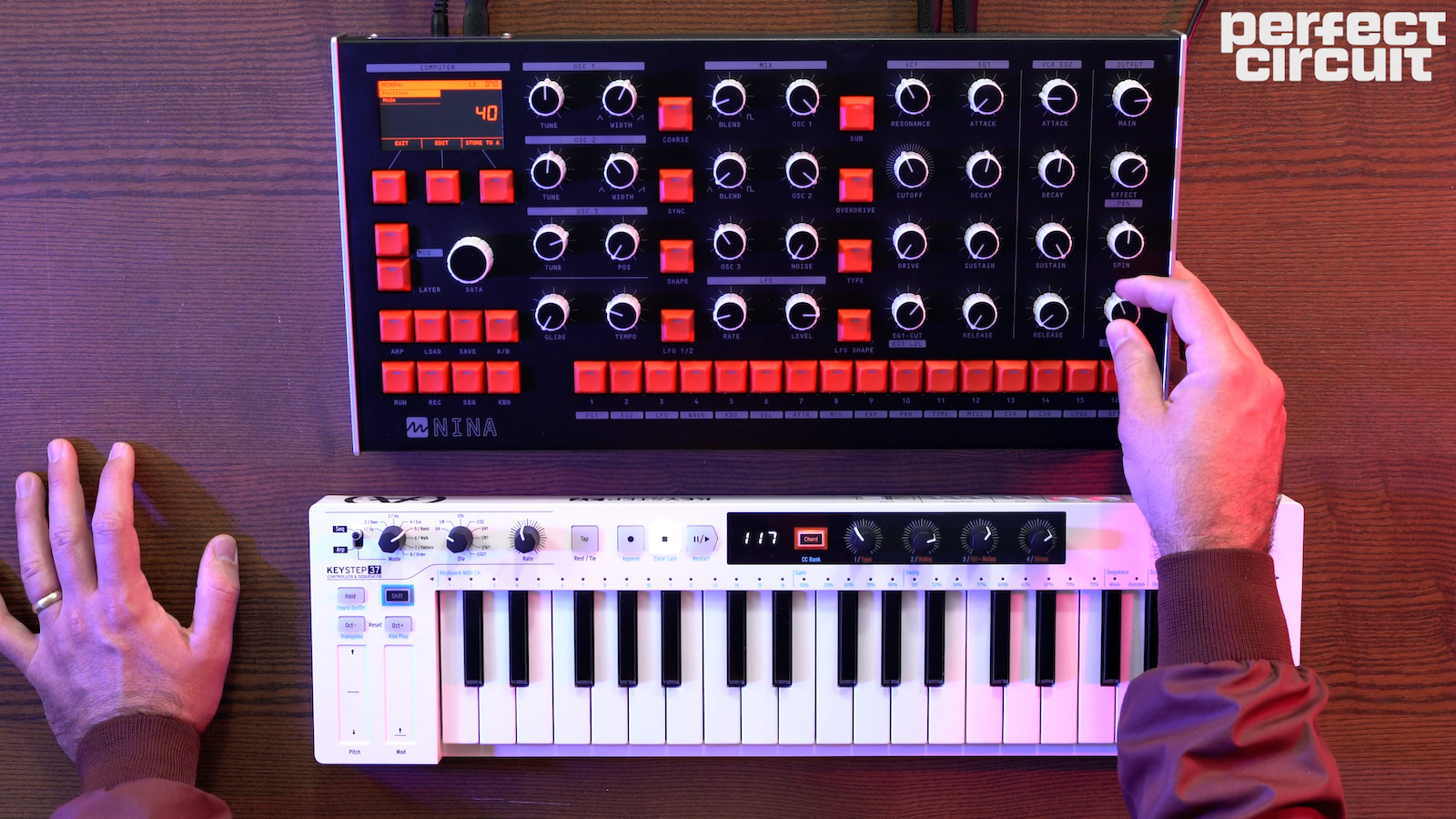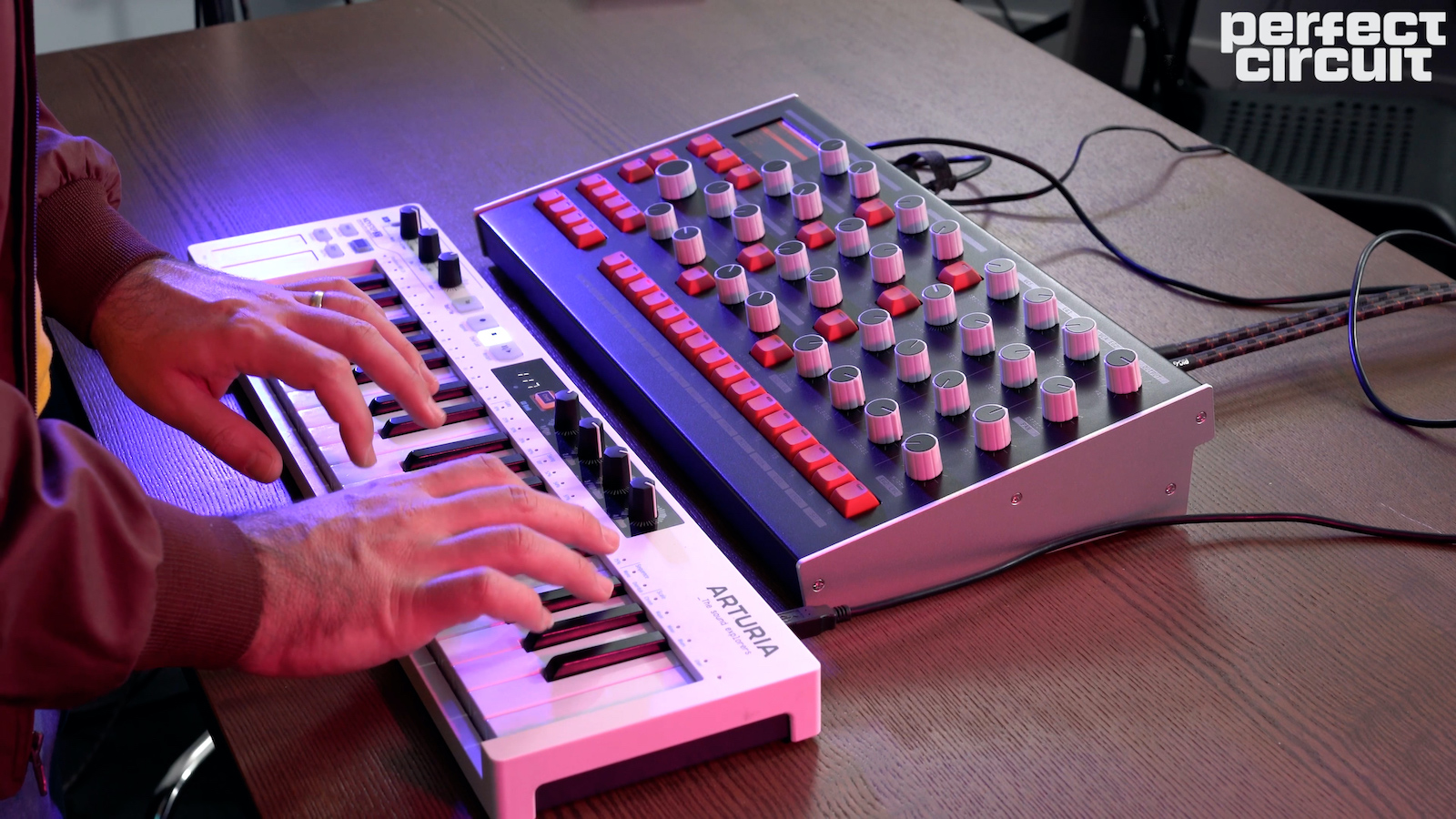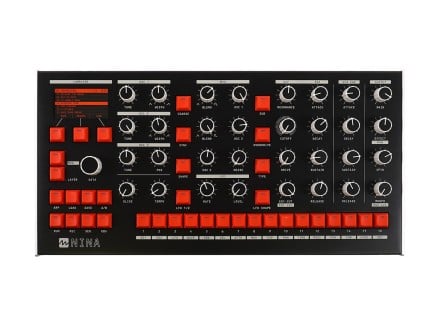A refreshing take on the all-in-one desktop synthesizer, the Nina from Melbourne Instruments fixes a problem that many digital and digitally controlled synthesizers have: a mismatch between settings and knobs. Change the patch on any other synthesizer and you get a new sound with the potentiometers in the same position—some have a handy screen display that tells you where the original location was, but others just don't, leaving you to adjust and break the setting quite easily.
Nina solves this problem using special motorized knobs, so that panel knob positions always reflect the patch's current settings. While that might at first seem like a gimmick, there's much more to Nina than just that…so let's take a look at what Nina contains, how it works, and some of the special possibilities afforded by those wild motorized knobs.
What is Nina?
Nina is a twelve-voice hybrid synthesizer with three oscillators per voice, 4-pole transistor ladder lowpass filters, overdrive, sampling capability, a sixteen-step sequencer, and more. It is four-part multitimbral, allowing the creation of splits, layers, overlapping zones, and assignment to separate MIDI channels. It also has four assignable outputs, making it possible to multi-track each timbre, if so desired. You also get controllable number of voices per timbre, a great way to get the most out of its multi-timbral behavior. It's great for simple pads or leads, but it can also create densely layered soundscapes with ease. But what actually comprises each layer?
By default, you have two analog oscillators, one wavetable oscillator, and one noise generator going into the mixer, which feeds the overdrive circuit before going into the filter section and terminating at the VCA, which can be routed to the effects section and any of the four outputs. With Elk OS, you can also easily adjust the effects that are being used, program your own, and more. The modulation path has both envelopes, LFOs, CV, Mod wheel and other modulation sources sent to the matrix for delivery to their final destination, which are any of the knob-laden parameters. And of course, all knobs reflect exactly what they are doing whether you're applying modulation or tweaking the sound.
The Elk Audio OS is a Linux distribution specifically designed for programming low latency audio applications; in Nina, it runs on a Raspberry Pi. This means that you can tweak the system to your own specifications if you know the software or are willing to learn—and in fact, Melbourne encourages "hacking" Nina to make it your own. Using this OS makes the generous audio routing possible, and it powers the incredibly versatile Mod Matrix, but it also allows for the signal path to remain stable.
A few synthesizers offer encoders that give you visual LED feedback to let you know where the settings are, but the Nina is in a league of its own. So, let's talk about one of Nina's most obvious features—its motorized encoders—and how they affect the way you use the instrument.
Luxury in Knob Form
Melbourne Instruments has elegantly solved this problem with in-house, bespoke motorized potentiometers based on the mechanics of brushless drone motors. These impressive feats of engineering are designed to last for several million revolutions, which is more than any standard mechanical potentiometer. While this is the most immediate difference that Nina has on pretty much every other synth on the market, there's also a ton of other features that make this a true centerpiece for your studio, including four sets of inputs and outputs, a combination of analog and digital oscillators, and a highly advanced patch morphing option.
Nina is perfect for compact studios with its small footprint and works incredibly well as a traveling powerhouse synth. In either situation it can be the centerpiece thanks to the wide array of sounds it's capable of producing and the ease with which you can adjust parameters. The oscillators, sure, contribute to this, however with Patch Morphing you can call up two different patches and continuously morph between them—finding sweet spots you never knew existed. Primary parameters are available for morphing, as well as the entire Modulation Matrix, which opens up the option for creatively controlled sonic spheres with a strong embrace of serendipity or intentionally-evolving structures.
Not Just a Gimmick
It's hard to ignore the exceptional craftsmanship of the Nina, but it's even harder to deny the fact that it sounds great and the workflow is quick. After using Nina with its WYSIWYG knobs, it feels like cheating: you want to adjust the timbre of oscillator 1? Well, you see exactly where the knobs are positioned. This also makes learning the instrument a much better and faster experience since you can blow through the presents, find something you like and instantly see how the sounds got to where they are. There is no guesswork.

The only thing that you can't readily see is the Modulation Matrix, at least not until you press the Mod button. The entire panel then switches to modulation mode with each knob now having a small haptic detent in the center position. Press a modulation source using the mechanical keys at the bottom, twist the knob you'd like to be modulated and you're done. You can also seamlessly morph between two presets with the Morph knob: just assign a preset to slot A and another to slot B and you can then blend between the two sounds including the modulation matrix. Aside from the sonic beauty of the sounds you can create, admittedly by accident, the aesthetics of watching those knobs gently undulate is mesmerizing.
Across three oscillators you can get a wide variety of sounds thanks to Oscillator 1 & 2 being triangle core analog VCOs with a triangle–square wave morphing and Oscillator 3 being a digital wavetable oscillator, with position sweep. Each oscillator has a dedicated volume control, making it easy to find exactly the right mix. And you will want to make use of this, as it is very easy to push the sound, even without the Drive knob up or Overdrive engaged. Now, if you want to get some dirt happening, go ahead and engage the Overdrive and pump up that Drive knob for nasty grit that can be further sculpted by the filter.
Another Revolution Around...

Nina is a sturdy powerhouse that has depth and complexity—spend a little time twiddling knobs finding your perfect sound and you will likely agree that there is something special about the synth. Not only does it have the benefit of keeping your knobs (read: brain) organized, but it also offers many options to keep you constantly revisiting your previous presets and creating new ones.
With customizable wavetables and effects, you're not locked into a particular series of sounds giving Nina the option to grow with you. With enough bells and whistles to entice the eye, but capable of being a gorgeous workhorse of a synth, Nina flows at the whims of your creativity with ease.










